|
|
|
|
|
Directory & Info for Fishing,
Angling, Fishing Tackle, Fishing Guides, Fly Fishing, Bass Fishing,
Sports fishing, Game Fishing....
See >>
Info on All types of
Fishing | Angling | Tackle etc
|
| |
|
Glossary of Fish, Seafood and Fishing Terms |
|
|
|
Australian Fish Bag Limits and Size Regulations |
|
Photos of Australian Seafood, Fish, Crustaceans &
Cephalopods and Information on each.... |
|
Abalone, Blacklip |
|
Albacore
Tuna |
|
Baler Shell |
|
Barbounia, Tiny |
|
Barracouta |
|
Barramundi |
|
Bass, Sea |
|
Batfish |
|
Batfish, Silver |
|
Blackfish |
|
Boarfish |
|
Bonito Tuna |
|
Bonito, Watson's Leaping |
|
Bream |
|
Bream, Butter |
|
Bream, Slate |
|
Bug, Moreton Bay
(Slipper Lobster) |
|
Bug, Balmain |
|
Butterfish |
|
Calamari,
Southern |
|
Carp, European |
|
Catfish, Blue |
|
Catfish, Lesser Salmon |
|
Cockles |
|
Cod, Bar |
|
Cod, Blue eye |
|
Cod, Coral Rock |
|
Cod, Ghost |
|
Cod, Maori |
|
Cod, Murray
|
|
Cod, Southern Rock |
|
Cod, Spotted |
|
Cod, Tomato |
|
Cod, Wirrah |
|
Cod, Yellow Spotted |
|
Coral Trout |
|
Cowanyoung |
|
Crab, Blue Swimmer |
|
Crab, Champagne |
|
Crab, Giant
|
|
Crab, Mud |
|
Crab, Spanner |
|
Crawfish |
|
Cuttlefish |
|
Dart Fish |
|
Dolphin Fish |
|
Dory, John |
|
Dory, Mirror |
|
Dory, Silver
|
|
Drummer, Southern |
|
Eel, Longfin |
|
Emperor, Red |
|
Emperor, Red Throat |
|
Flathead |
|
Flounder, Small Toothed |
|
Flutemouth, Rough |
|
Frost Fish |
|
Garfish |
|
Gemfish |
|
Goatfish |
|
Grouper |
|
Gurnard, Red |
|
Gurnard, Spotted |
|
Hairtail |
|
Hump Headed
Maori Wrasse |
|
Hussar |
|
Jackass Fish |
|
Jacket, Ocean |
|
Jacket, Sea |
|
Jewfish |
|
Jobfish, Gold Banned |
|
Jobfish, Rosy |
|
Kingfish,
Yellowtail |
|
Latchet Fish |
|
Leatherjacket, Reef |
|
Ling |
|
Lobster - Eastern
Rock |
|
Lobster - Southern Rock |
|
Long Tom |
|
Luderick |
|
Mackeral, Jack |
|
Mackerel, Slimey |
|
Mado |
|
Mahi Mahi |
|
Mangrove Jack |
|
Marlin, Black |
|
Marlin, Blue |
|
Marlin, Striped |
|
Melon Shell |
|
Monkfish |
|
Mono |
|
Moon Fish |
|
Morwong |
|
Morwong, Red |
|
Mullet - Roe |
|
Mullet, Diamond Scale |
|
Mullet, Red |
|
Mullet, Sea |
|
Mullet, Yelloweye |
|
Mulloway |
|
Mussels Black |
|
Mussels Greenlip |
|
Nanygai |
|
Octopus |
|
Orange Roughy |
|
Oreo, Black |
|
Oyster,
Native |
|
Oyster,
Pacific |
|
Oyster, Sydney Rock |
|
Parrot Fish |
|
Parrot Fish (2) |
|
Perch, Ocean |
|
Perch, Saddle Tail Sea |
|
Perch, Silver |
|
Perch, Splendid |
|
Perch, Stripey Sea |
|
Pig Fish |
|
Pike |
|
Pineapple Fish |
|
Prawn, Banana |
|
Prawn, King |
|
Prawn, Red Spot |
|
Prawn, School |
|
Prawn, Tiger |
|
Queenfish, Needleskin |
|
Rainbow Runner |
|
Redclaw Crayfish |
|
Redfish |
|
Ribaldo |
|
Ribbon Fish |
|
Rudder Fish |
|
Salmon, Atlantic |
|
Salmon, Australian |
|
Scad |
|
Scallops,
Queensland |
|
Scallops, Tasmanian |
|
Scorpion Fish, Raggy |
|
Shark |
|
Shark Black Tip |
|
Shark, Blue |
|
Shark Bronze Whaler (Dusky) |
|
Shark, Bull |
|
Sharks Fins |
|
Shark, Gummy |
|
Shark, Mako |
|
Shark, School |
|
Shark,
Tiger |
|
Shark,
Whiskery Reef |
|
Shark, White |
|
Shrimp, Mantis |
|
Sicklefish |
|
Silver Biddy |
|
Snapper |
|
Snapper, Big Eye |
|
Snapper, Fry Pan |
|
Snapper, Gold Band |
|
Snapper, King |
|
Snapper,
Red |
|
Snapper, Red Tropical |
|
Sole |
|
Sole, Tongue |
|
Squid, Arrow |
|
Squirrel Fish |
|
Stargazer |
|
Stingray, Butterfly |
|
Stripey Sea
Perch |
|
Surgeonfish, Sixplate Sawtail |
|
Sweetlip, Slatey |
|
Sweetlip, Yellow |
|
Swordfish |
|
Tailor |
|
Tarwhine |
|
Tilefish,
Pink |
|
Trevally, Big Eye |
|
Trevally, Golden |
|
Trevally, Silver |
|
Triple Tail |
|
Trout |
|
Trumpeter, Striped |
|
Tuna,
Albacore |
|
Tuna, Bigeye |
|
Tuna, Bluefin |
|
Tuna, Longtail |
|
Tuna, Skipjack |
|
Tuna, Striped |
|
Tuna, Mackerel |
|
Tuna, Yellowfin |
|
Venus Tusk Fish |
|
Whiting, Sand |
|
Whiting, School |
|
Wrasse |
|
Yabby,
Freshwater Crayfish |
|
Yellowtail |
|
FULL LIST of Fish &
Seafood |
|
Beche De Mer
(Sea Cucumber - Trepang) |
|
Amberfish |
|
Blackfish |
|
Black Teatfish |
|
Brown Sandfish |
|
Curryfish |
|
Elephants Trunks fish |
|
Greenfish |
|
Lollyfish |
|
Pinkfish |
|
Prickly Redfish |
|
Sandfish |
|
Stonefish |
|
Surf Redfish |
|
White Teatfish |
|
|
|
Commercial Seafood
Directory |
|
Sea-Ex Seafood, Fishing, Marine
Directory |
|
Aquaculture Directory |
|
Seafood
Trading Board |
|
Commercial Fishing |
|
Seafood Information by
Country |
|
Fish Photos & Fish
Information |
|
Interesting Fish Facts & Trivia |
|
Country Directories |
|
Thailand Business
Directory |
|
Seafood
|
|
Wholesale Seafood
Suppliers Australia |
|
Wholesale Seafood
Suppliers International |
|
Retail Seafood
Sales |
|
Seafood
Restaurants |
|
Seafood
Recipes |
|
Seafood
Information |
|
Seafood
Industry Resources |
|
Sea-Ex Seafood & Fishing
Directory -
Home Page |
|
Trout Photographs
and Information
|
The Trout is a number of
species of freshwater and saltwater fish belonging to the
Salmoninae subfamily of the Salmonidae family. Salmon belong to
some of the same genera as trout but, unlike most trout, most
salmon species spend almost all their lives in salt water. Trout
are classified as an oily fish
Trout that live in
different environments can have dramatically different
colorations and patterns. Mostly, these colors and patterns
form as camouflage, based on the surroundings, and will
change as the fish moves to different habitats. Trout in, or
newly returned from the sea, can look very silvery, while
the same "geneic" fish living in a small stream or in an
alpine lake could have pronounced markings and more vivid
coloration; it is also possible that in some species this
signifies that they are ready to mate. It is virtually
impossible to define a particular color pattern as belonging
to a specific breed; however, in general, wild fish are
claimed to have more vivid colors and patterns.
Trout have fins entirely without spines, and all of them
have a small adipose (fatty) fin along the back, near the
tail. There are many species, and even more populations that
are isolated from each other and morphologically different.
However, since many of these distinct populations show no
significant genetic differences, what may appear to be a
large number of species is considered a much smaller number
of distinct species by most ichthyologists. The trout found
in the eastern United States are a good example of this. The
brook trout, the aurora trout, and the (extinct) silver
trout all have physical characteristics and colorations that
distinguish them, yet genetic analysis shows that they are
one species, Salvelinus fontinalis.
|
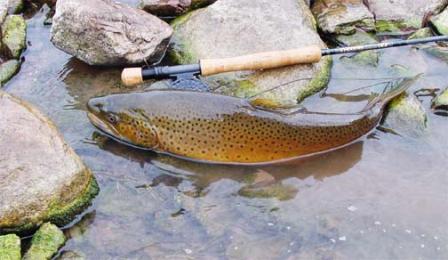 |
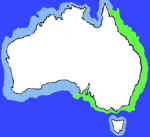 |
Did you know? A
group of trout is called a "hover"
Did you know?
Lake trout (Salvelinus namaycush), like brook trout, belong
to the char genus. Lake trout inhabit many of the larger
lakes in North America, and live much longer than rainbow
trout, which have an average maximum lifespan of 7 years.
Lake trout can live many decades, and can grow to more than
30 kilograms (66 lb).
Did you know? Trout
is naturally low in sodium and calories. It also has high levels
of Omega-3 fatty acids, which have been proven to lower blood
triglycerides and cholesterol levels, reduce risk of death from
coronary and cardiovascular disease, reduce blood pressure and
relieve the pain of rheumatoid arthritis.
|
| Scientific Name |
Salmo trutta |
| Location in Australia |
- |
| Season |
All year round |
| Size |
30 - 58 cm |
| Australian Species Code |
37 441005 |
|
Nutritional
Information
For every 100 grams raw product
for Trout fillet. |
|
Kilojoules |
550 (131
calories) |
|
Protein |
18.4g |
|
Cholesterol |
35 mg |
|
Sodium |
39 g |
|
Total fat
(oil) |
0.9 g |
|
Saturated
fat |
24% of total
fat |
|
Monounsaturated fat |
19% of total
fat |
|
Polyunsaturated fat |
57% of total
fat |
|
Omega-3, EPA |
54 mg |
|
Omega-3, DHA |
191 mg |
|
Omega-6, AA |
66 mg |
|
Other
Trout Links:
Trout Recipes
Producers of Trout
Processors of Trout
Exporters of Trout
Importers of Trout
Wholesale Suppliers of Trout
Agents for Trout
|
|
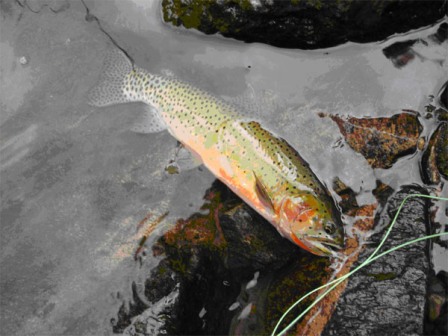 Habitat Habitat
Trout are usually found in cool (50–60 °F, 10–16 °C), clear
streams and lakes, although many of the species have anadromous strains as well.
Young trout are referred to as troutlet, troutling or fry. They are distributed
naturally throughout North America, northern Asia and Europe. Several species of
trout were introduced to Australia and New Zealand by amateur fishing
enthusiasts in the 19th century, effectively displacing and endangering several
upland native fish species. The introduced species included brown trout from
England and rainbow trout from California. The rainbow trout were a steelhead
strain, generally accepted as coming from Sonoma Creek. The rainbow trout of New
Zealand still show the steelhead tendency to run up rivers in winter to spawn.
Diet
Trout generally feed on other fish, and soft bodied
aquatic invertebrates, such as flies,
mayflies, caddisflies, stoneflies,
mollusks and dragonflies
. In lakes, various species of zooplankton often form a
large part of the diet. In general, trout longer than about 300 millimetres (12
in) prey almost exclusively on fish, where they are available. Adult trout will
devour smaller fish up to 1/3 their length. Trout may feed on shrimp, mealworms,
bloodworms, insects, small animal parts, and eel. |
Angling for Trout | Trout
Fishing
:
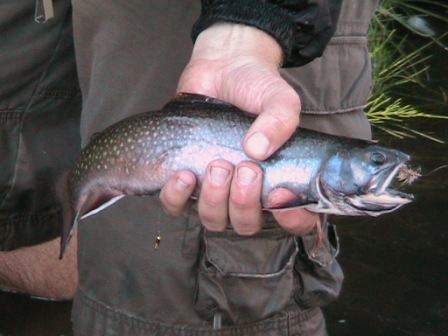 Understanding
how moving water shapes the stream channel will improve your chances of finding
trout. In most streams, the current creates a Riffle-Run-Pool pattern that
repeats itself over and over. A deep pool may hold a big brown trout, but
rainbows and smaller browns are likely found in runs. Riffles are where you will
find small trout, called troutlet, during the day and larger trout crowding in
during morning and evening feeding periods. Understanding
how moving water shapes the stream channel will improve your chances of finding
trout. In most streams, the current creates a Riffle-Run-Pool pattern that
repeats itself over and over. A deep pool may hold a big brown trout, but
rainbows and smaller browns are likely found in runs. Riffles are where you will
find small trout, called troutlet, during the day and larger trout crowding in
during morning and evening feeding periods.
Riffles have a fast current and shallow water. This gives way to a bottom of
gravel, rubble or boulder. Riffles are morning and evening feeding areas. Trout
usually spawn just above or below riffles, but may spawn right in them.
Runs are deeper than riffles with a
moderate current and are found between riffles and pools. The bottom is made up
of small gravel or rubble. These hot spots hold trout almost anytime, if there
is sufficient cover.
Pools are smoother and look darker than
the other areas of the stream. The deep, slow-moving water generally has a
bottom of silt, sand, or small gravel. Pools make good midday resting spots for
medium to large trout.
It is recommended that when fishing for
trout, that the fisher(s) should use line in the 4-8 lb test for streamfish, and
stronger line with the same diameter for trout from the sea or from a large
lake, such as Lake Michigan. It is also recommended to use a hook size 8-5 for
trout of all kind.
Trout also find salmon eggs, worms,
minnows, cut bait, or corn attractive with corn and the occasional marshmallow
especially attractive to farm raised trout. See
Bait
For Trout
|
|
Cooking
Trout
:
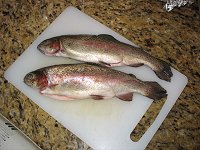 As
a group, trout are somewhat bony, but the flesh is generally
considered to be tasty. Additionally, they provide a good fight
when caught with a hook and line, and are sought after
recreationally. Because of their popularity, trout are often
raised on fish farms and planted into heavily fished waters, in
an effort to mask the effects of overfishing. While they can be
caught with a normal rod and reel, fly fishing is a distinctive
method developed primarily for trout, and now extended to other
species. Farmed trout and char are also sold commercially as
food fish. As
a group, trout are somewhat bony, but the flesh is generally
considered to be tasty. Additionally, they provide a good fight
when caught with a hook and line, and are sought after
recreationally. Because of their popularity, trout are often
raised on fish farms and planted into heavily fished waters, in
an effort to mask the effects of overfishing. While they can be
caught with a normal rod and reel, fly fishing is a distinctive
method developed primarily for trout, and now extended to other
species. Farmed trout and char are also sold commercially as
food fish.
According to the British Nutritional Foundation, trout contain
one of the lowest amounts of dioxins (a type of environmental
contaminant) of all oily fishes.
Trout is a good source
of
Omega-3 "good" oils, which are considered essential
fatty acids.
The small (plate size)
and some larger rainbow trout are grown in freshwater ponds
in commercial trout farms. Tasmanian trout farmers transfer
young trout of about 400 g to sea cages and rear them to a
common size of 2.5 -3.5 kg. These rainbow trout are often
described as ocean trout or sea-run trout . Trouts have an
excellent recovery rate due to the small head and
barrel-shaped body.
No true trouts are native to Australia. Rainbow trout
and brown trout were first introduced to Tasmania and
are now widely distributed throughout New South Wales and
Victoria, and to a lesser extent South Australia and Western
Australia.
Large trouts are
regarded by many people as being equal to the Atlantic
salmon in taste and texture, and can be used as an
alternative.
Steaming, poaching, smoking, grilling and barbecuing are
popular cooking methods for trout, but for excellent
presentation and ease of preparation probably the best
method is to bake and serve them whole.
It is important to remember that trout cooks quickly.
Leaving the skin on helps hold the fish together when
sautČing or grilling, and skinning the trout after cooking
is much easier.
Suitable accompaniments for trout include nuts (particularly
almonds), sweet and sour cucumber relish, or a stuffing of
wild mushrooms, pesto and parmesan crusts (which make for a
rich additive to enhance the flavour).
Prepare the delicacy gravalax using trout (instead of the
traditional salmon) by marinating thinly sliced fillets in
white wine, dill and rock salt. The orange/pink flesh also
makes an attractive salad or mousse or can be used for sushi
and sashimi.
Microwave Cooking
Times for Fish
- Fish fillets – 5 minutes per 500g on medium-high, +50
seconds more for thicker fillets, or until flesh flakes
- Whole fish - Large – 6 minutes/750g on medium
- Whole fish – Small – 3-4 minutes on medium
|
|
Commercial Fishing for Trout: Trout are born from the species Salmo and
are carried back down stream where they become referred to as the more common
name, Salmon. The name trout is commonly used for some species in three of the
seven genera in the subfamily Salmoninae: Salmo, Atlantic species; Oncorhynchus,
Pacific species; and Salvelinus, which includes fish also sometimes called char
or charr. Fish referred to as trout include:
Genus Salmo
Adriatic trout, Salmo obtusirostris
Brown trout, Salmo trutta
Flathead trout, Salmo platycephalus
Marmorata, Soca River trout or Soča trout - Salmo trutta marmoratus
Ohrid trout, Salmo letnica
Sevan trout, Salmo ischchan
Genus Oncorhynchus
Apache trout, Oncorhynchus apache
Seema, Oncorhynchus masou
Cutthroat trout, Oncorhynchus clarki
The cutthroat trout has 15 recognized subspecies (depending on sources), such as
the Lahontan cutthroat trout, Oncorhynchus clarki henshawi, Bonneville cutthroat
trout, Oncorhynchus clarki utah, Colorado River cutthroat trout, Yellowstone
cutthroat trout.
Gila trout, Oncorhynchus gilae
Golden trout, Oncorhynchus aguabonita
Rainbow trout, Oncorhynchus mykiss
Mexican Golden Trout, Oncorhynchus chrysogaster and as many as eight other
species or sub-species in northwest Mexico, not yet formally named.
Genus Salvelinus (Char)
Arctic char, Salvelinus alpinus
Aurora trout, Salvelinus fontinalis timagamiensis
Brook trout, Salvelinus fontinalis
Bull trout, Salvelinus confluentus
Dolly Varden trout, Salvelinus malma
Lake trout, Salvelinus namaycush
Silver trout, † Salvelinus fontinalis agassizi (extinct)
See Also:
Brook
Trout,
Brown
Trout,
Coral
Trout,
Golden
Trout,
Rainbow Trout,
Sea Trout,
Smoked
Trout
Rainbow trout (Oncorhynchus
mykiss) and brown trout (Salmo trutta) have a long history of
aquaculture and rainbow trout is one of the few species of fish
which may be regarded as truly domesticated. Rainbow trout
originate from western North America, while brown trout are
native to Europe. In 1995, world aquaculture production of
rainbow trout was approximately 360,000 tonnes, valued at
approximately US $1.3 billion, while the total global production
for all salmonids (including smelts) was approximately 943,000
tonnes and US $3.7 billion species whereas brown trout are
generally grown only for recreational fishing.
Trout have been cultured since the mid-1800s using ponds, tanks,
raceways and, more recently, cages. Consequently, the
environmental and nutritional requirements and design of farms
for trout are well understood. Overall, trout have a high demand
for water of a high quality throughout the year.
Brown trout have been in Western Australian waters since 1931
and rainbow trout since 1942. Both species of trout were
originally introduced to our waters to provide food and
recreational fishing, there being no large freshwater native
species in southern areas except for the native catfish (Tandanus
bostocki). As trout came from cooler, temperate climates, their
distribution in WA is restricted to the south-west corner of the
State.
In 1935, a hatchery was developed at Pemberton in the south-west
of WA, for breeding both brown and rainbow trout. The hatchery
is now operated by the Department of Fisheries as part of the
South West Freshwater Research and Aquaculture Centre (SWFRAC)
and provides juvenile and yearling rainbow and brown trout for
stocking of public rivers and dams for recreational fishing, to
farmers to stock their dams, to fish farms for commercial trout
grow-out, and for saline inland aquaculture of rainbow trout.
There is a small established trout aquaculture industry in
Western Australia. Currently, there are three farms commercially
producing trout in WA and this low number of producers prevents
the release of specific trout production data (see Cole et al.,
1999). The commercial production from the aquaculture of trout
in WA had reached 40 tonnes per annum, valued at around $400,000
(McNee et al., 1993). However, due to the reduced number of
commercial farms and the diversion of production for fish-out
(pay to fish) operations, the local industry has contracted.
Australia-wide, over 9,000 tonnes of trout and salmon were
produced in 1997/98, worth more than A$75 million (ABARE 1998).
Rainbow trout (also called 'ocean trout') are produced in sea
cages in Tasmania, but over 2,000 tonnes of rainbow trout were
produced from land-based culture with a value of A$12.7 million,
mostly from Victoria. Only land-based trout culture is practised
in Western Australia. Attempts to farm rainbow trout in sea
cages off the south coast have been limited by warm water
temperatures, the lack of sheltered sites and poor public
reception. However, alternative sites for large-scale production
of rainbow trout are currently being examined.
Producers of Trout |
Processors of Trout |
Exporters of Trout |
Importers of Trout |
Wholesale Suppliers of Trout |
Agents
for Trout See
Also Commercial Fishing Suppliers for:
Brook
Trout,
Brown
Trout,
Coral
Trout,
Golden
Trout,
Rainbow Trout,
Sea Trout,
Smoked
Trout
More links about
Trout and Trout Information |
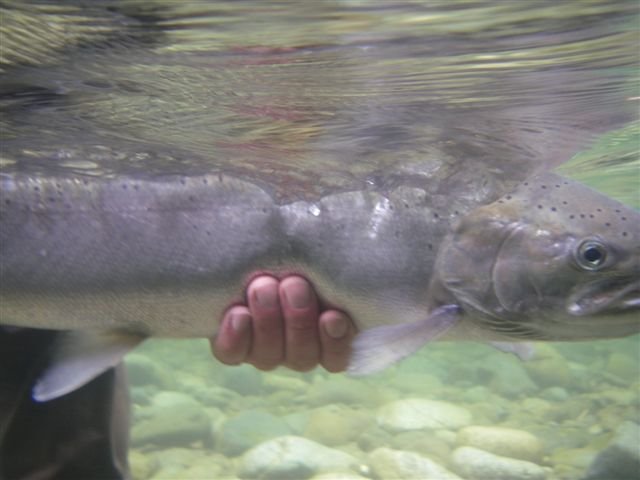
Winter Steelhead is released back into the Stamp River - Sensational
picture by Doug Lindores of
Slivers Charters
Salmon Sport Fishing
|